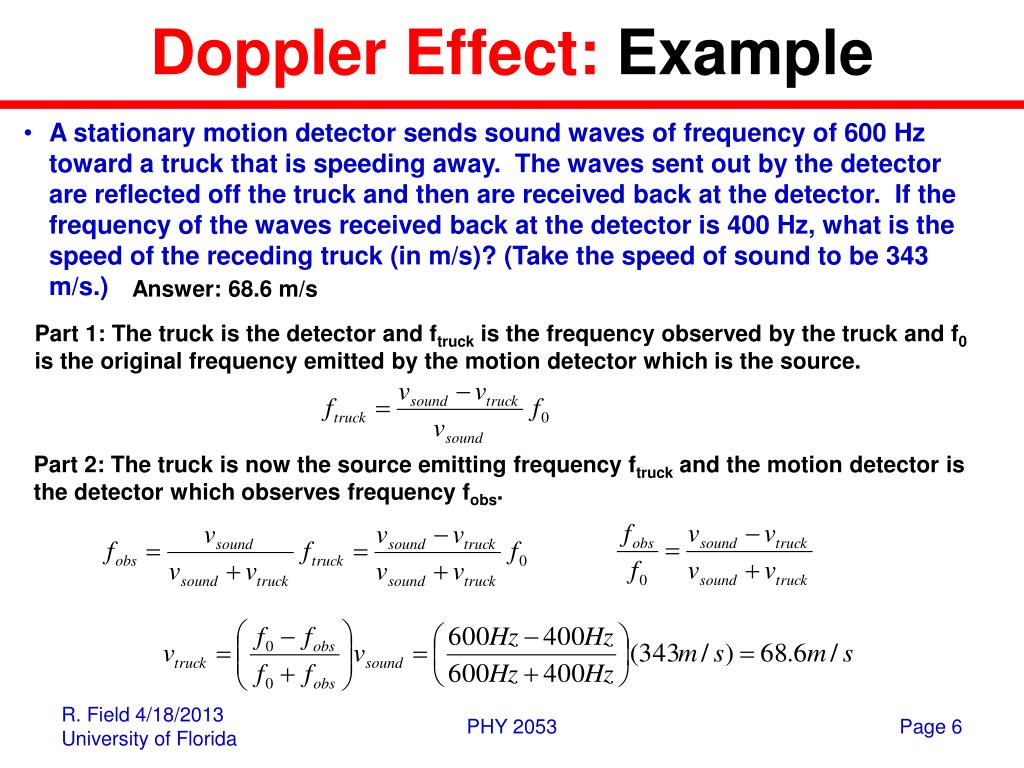

The speed of the source of the sound (v s) = 20 m/s The frequency of the source of the sound is 380 Hz and the speed of the sound waves in air is 400 m/s What is the frequency of the sound waves heard by the observer. A source of sound moves at 10 m/s approach a stationary observer.
#Doppler effect example driver#
Wanted: Frequency of sound heard by the driver of the car B from car Aĥ. The speed of the sound waves in air (v) = 350 m/s The frequency of the sound of car A (f A) = 650 Hz The speed of car B (v B) = 90 km/h = 25 m/s, approach car A The speed of car A (v A) = 72 km/h = 20 m/s, approach car B If the speed of the sound waves in air is 350 m/s, then what is the frequency of sound heard by the driver of car B from car A. Car A moves at 72 km/h and car B moves at 90 km/h, approach each other. Wanted: The frequency of the sound waves heard by the observerĤ. The speed of the source of the sound waves (v) = 400 m s -1 The frequency of the source of the sound (f) = 380 Hz The speed of the source of the sound (v source) = 20 m/s See also Pressure of fluids – problems and solutions What is the frequency of the sound waves heard by the observer? The speed of the sound waves in air = 400 m s -1. The frequency of the source of the sound = 380 Hz.

A source of sound moving toward the stationary observer at 20 m/s. The beat frequency heard by the observer = 684 Hz – 680 Hz = 4 Hz.ģ. The observer speed (v obs) is negative if observer moving away from the source of the sound Wanted: The beat frequency heard by the observer The speed of the source of the sound waves in air (v) = 340 m/s The speed of the source of the sound 2 (v 2) = 2 m/s (moving toward the observer) The frequency of the source of the sound 2 (f 2) = 676 Hz (move) The frequency of the source of the sound 1 (f 1) = 684 Hz (rest) If the speed of the sound waves in air is 340 m/s, then what is the beat frequency heard by the observer. Another the source of the sound of 676 Hz moving toward the observer at 2 n/s. An observer at rest near the source of the sound of frequency 684 Hz. If the source of the sound and observer moves at the same speed then no Doppler effect occurs.Ģ. Observer and source are moving at the same speed The source speed (v s ource ) is negative if the source of the sound moving toward the observer The source speed (v source) is negative if the source of the sound moving toward an observer Source moving toward the stationary observer The source of the sound at rest so v source = 0 The o bserver speed ( v obs ) is positive if observer moving toward the source of the sound The source speed (v source) = 40 m/s, if the source of the sound at rest then v source = 0Īn observer moving toward the stationery source

The observer speed (v obs) = 60 m/s, if observer at rest then v obs = 0 The source speed (v source) = 0 if source at rest

The observer speed (v obs) = 0 if an observer at rest The source speed (v source) is negative if the source of the sound moving toward the observer The source speed (v source) is positive if the source of the sound moving away from the observer The observer speed (v obs) is negative if the observer moving away from the source of the sound The observer speed (v obs) is positive if observer moving toward the source of the sound If the pitch heard is higher than that of the emitted source frequency, then which statement above are correc t : (4) observer and source are moving at the same speed (3) observer and source approach each other (2) source moving toward the stationary observer (1) an observer moving toward the stationery source


 0 kommentar(er)
0 kommentar(er)
